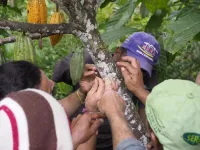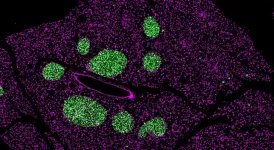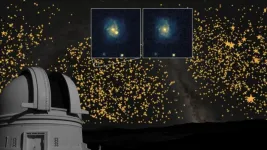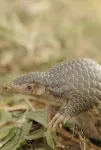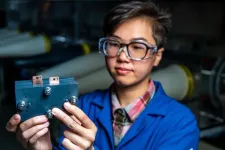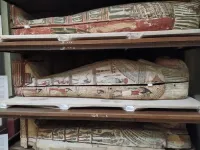(Press-News.org) Palmyra is one of the most famous sites in Syria for its extraordinary heritage and archaeological remains. Inscribed on the World Heritage List in 1980, the city saw much of its heritage destroyed during the war. Following the liberation of Syria from the Assad regime on 8 December, a multidisciplinary team has carried out a field study in Palmyra to assess the current state of the archaeological monuments and the surrounding residential areas, comparing them with their condition before the start of the Syrian uprising in 2011. The report is an initiative of Palmyrene Voices of the NGO Heritage for Peace in collaboration with the CSIC's Milà i Fontanals Institution.
‘We want,’ says Isber Sabrine, a CSIC archaeologist and one of the report's coordinators, ’to raise awareness among both local communities and the international community about the serious threats facing Palmyra's heritage’. Sabrine is an archaeologist of Syrian origin and currently a researcher at IMF-CSIC. Hasan Ali and Mohammed Fares, also archaeologists and members of the Palmyrene Voices initiative, coordinated the report. A team of 15 observers contributed data for the report, including citizens of Palmyra, archaeologists and refugees who have recently returned to the city.
80% of the city destroyed or on the verge of collapse
The report highlights historical and recent challenges, including periods of repression under the presidencies of Hafez al-Assad (1971-2000) and Bashar al-Assad (2000-2024), as well as devastating damage during the occupation by the Islamic State (ISIS).
The documented buildings and archaeological remains cover approximately 12 square kilometres, including the Efqa Oasis.
The latter, some 400 hectares in size, was burnt to the ground in the 2020 fires set by the Assad regime. The remaining trees in parts that no longer receive water have dried out and turned into dead wood. At present, as observers have documented, some returning orchard owners are trying to save what is left of their palm and olive trees.
Eighty per cent of the city's buildings are destroyed or at risk of collapse, the report says, and landmines and weapons are scattered everywhere. Basic services such as water, electricity, internet, education and health are almost non-existent in the population, which suffers from severe poverty. Some 10,000 people have returned, about 10 per cent of Palmyra's 100,000 inhabitants.
Damage to archaeological heritage
Observers have documented damage to the 12 most important monuments and archaeological sites, including Roman remains such as the Tetrapylon (a monumental square platform bearing at each corner a tight grouping of four columns, dating from the 2nd century), and the Roman theatre (both 2nd century), the Camp of Diocletian (3rd century), the Castle of Palmyra or Qalʿat Ibn Maʿn (13th century), the Valley of the Tombs (1st century), the Archaeological Museum of Palmyra, among others.
Thus, for example, the four structures of the Tetrapylon were destroyed by explosions that reduced their columns to rubble and scattered stone fragments. It is also noted that there is no evidence of documentation or numbering of the stones, which, if present, could be helpful in their reconstruction. The BaalShamin Temple, around 2,200 years old, has been reduced to rubble.
On the Roman theatre, researchers have found evidence of a collapse of the façade, damaged by bombing. Signs of illegal excavations have also been found.
Regarding the Archaeological Museum, the report notes that most of the heavy statues and funerary beds are smashed or broken, and the structure of the building is badly damaged by aerial bombardment. The museum is not operational, but guards from the Directorate of Antiquities and some local volunteers protect it without support from the new administration. In addition, there are no administrative staff to supervise the museum.
The availability of more staff for heritage protection and conservation in Palmyra is directly linked to the return of its population, say the report's authors. ‘The city currently faces significant challenges due to the devastation caused by the conflict, which has led to the massive displacement of its inhabitants.
Acute need to rebuild
The report notes that in order for Palmyra to regain its vitality and human resources to manage its heritage, it is essential to prioritise the reconstruction of its basic infrastructure and habitable areas. ‘Without housing, essential services and economic opportunities, the return of the population will be limited, making it difficult for local professionals and workers to be available for heritage conservation,’ notes Isber Sabrine.
The report ‘seeks to inspire local and international communities to recognise the threats facing Palmyra and the pressing need to rehabilitate and reconstruct its archaeological site, oasis and residential areas’.
It also ‘underlines the urgent need to implement rehabilitation and reconstruction strategies for the archaeological site and the modern city of Palmyra to ensure the conservation of this globally important site and the return of the people’.
This joint action reinforces the commitment of the IMF-CSIC and the Palmyra Voices Initiative to the defence of cultural heritage and the reconstruction of a post-conflict Syria.
CSIC Communication
END
University of Virginia Brain Institute and School of Medicine researchers have received an initial $9.3 million award from the National Institutes of Health for a $30 million clinical trial to determine if the powerful anesthetic ketamine can save patients from prolonged, life-threatening grand mal seizures that won’t respond to other treatments.
“Status epilepticus,” as the seizures are known, are seizures that last more than five minutes or that strike repeatedly without the ...
Digital@INSEAD is hosting a free TECH TALK X webinar, “The Future of Agentic AI & Autonomous Organizations” on Thursday, 27 February 2025 at 9.00 am ET / 3.00 pm CET (60 min).
AI is evolving beyond tools and assistants – it is becoming autonomous. But what is holding enterprises back from fully leveraging Agentic AI?
Join in the free webinar for a deep dive with Rotem Alaluf, CEO of Wand – a pioneering platform for enterprise-grade AI systems – and Peter Zemsky, ...
Cocoa (Theobroma cacao L.) is a vital cash-crop for four to six million small-holder farmers across the tropics, and supports a global chocolate industry valued at over USD 100 billion annually. The combination of millions of farmers relying on cocoa for their livelihoods, and increasing global demand for the crop, has driven cocoa plantation expansion and intensification of farming practices, often at the expense of biodiversity and long-term sustainability.
A new research study led by the University ...
A recent study reveals that age plays a significant role in the outcomes of intermittent fasting. Researchers from Technical University of Munich (TUM), LMU Hospital Munich, and Helmholtz Munich discovered that chronic intermittent fasting disrupted the development of insulin-producing beta cells in young mice. The findings raise concerns about potential risks for humans, especially teenagers.
“Intermittent fasting is known to have benefits, including boosting metabolism and helping with ...
Astrophysicists have unearthed a surprising diversity in the ways in which white dwarf stars explode in deep space after assessing almost 4,000 such events captured in detail by a next-gen astronomical sky survey. Their findings may help us more accurately measure distances in the Universe and further our knowledge of “dark energy”.
The dramatic explosions of white dwarf stars at the ends of their lives have for decades played a pivotal role in the study of dark energy – the mysterious force responsible for the accelerating expansion of the Universe. They also provide the origin of many elements in our ...
Pangolins are unique as they are the only mammal to be covered in scales. Even though they are scaly, photos of them are typically met with “awwws” from the viewers who find them adorable. Importantly, though, pangolins play an essential role in maintaining their ecosystem. Their other “unique trait” is that they are the most trafficked wild animal in the world, with more than 900,000 poached in the past two decades. Much of this is due to their high value for use in traditional medicine that ...
We hope to be cured when we stay in hospital. But too often, we acquire new infections there. Such ‘healthcare-associated infections’ (HAI) are a growing problem worldwide, taking up an estimated 6% of global hospital budgets. In the EU alone, HAIs add up to more than 3.5 million cases per year, resulting in 2.5 million disability-adjusted life years, a cost of up to €24 billion, and 90,000 deaths. They are likewise the sixth leading cause of death in the US.
Patients with lowered immune defenses, and in some hospitals, ...
RICHLAND, Wash.—Sometimes, in order to go big, you first have to go small. That’s what researchers at the Department of Energy’s Pacific Northwest National Laboratory have done with their latest innovation in energy storage.
With a goal to speed the time to discovery of new grid energy storage technology, the team designed a compact, high-efficiency flow battery test system that requires an order of magnitude less starting material while delivering results equal to the standard lab-scale ...
Collaboration efforts between the Texas A&M University Artie McFerrin Department of Chemical Engineering and the U.S. Department of Energy Advanced Research Projects Agency-Energy (ARPA-E) have led to innovative research on how petroleum coke is processed.
This almost $3 million three-year research project will convert petroleum coke to graphite for energy storage. The newer process uses a lower temperature and shorter time to produce graphite from petroleum coke.
This new catalytic graphitization technology will ...
UCL Press Release
Under embargo until Friday 14 February 2025, 00:01 UK time / 19:01 Thursday 13 February US Eastern time
Ancient Egyptian mummified bodies smell ‘woody,’ ‘spicy’ and ‘sweet’, finds a new study led by researchers from UCL and the University of Ljubljana, revealing new details about mumification practices.
The research, published in Journal of the American Chemical Society, is the first time that the smells of mummified bodies have been systematically studied combining a mix of instrumental and sensory techniques, including an electronic ‘nose’ ...


